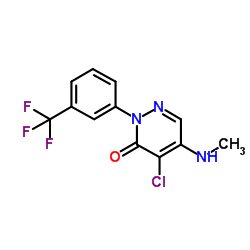Norflurazon

Norflurazon structure
|
Common Name | Norflurazon | ||
|---|---|---|---|---|
| CAS Number | 27314-13-2 | Molecular Weight | 303.67 | |
| Density | 1.5±0.1 g/cm3 | Boiling Point | 345.2±52.0 °C at 760 mmHg | |
| Molecular Formula | C12H9ClF3N3O | Melting Point | 184ºC | |
| MSDS | Chinese USA | Flash Point | 162.6±30.7 °C | |
| Symbol |

GHS09 |
Signal Word | Warning | |
|
A new F131V mutation in Chlamydomonas phytoene desaturase locates a cluster of norflurazon resistance mutations near the FAD-binding site in 3D protein models.
PLoS ONE 9(6) , e99894, (2014) The green alga Chlamydomonas reinhardtii provides a tractable genetic model to study herbicide mode of action using forward genetics. The herbicide norflurazon inhibits phytoene desaturase, which is required for carotenoid synthesis. Locating amino acid subst... |
|
|
Novel bioassay for the discovery of inhibitors of the 2-C-methyl-D-erythritol 4-phosphate (MEP) and terpenoid pathways leading to carotenoid biosynthesis.
PLoS ONE 9(7) , e103704, (2014) The 2-C-methyl-D-erythritol 4-phosphate (MEP) pathway leads to the synthesis of isopentenyl diphosphate in plastids. It is a major branch point providing precursors for the synthesis of carotenoids, tocopherols, plastoquinone and the phytyl chain of chlorophy... |
|
|
Functional characterization of the two ferrochelatases in Arabidopsis thaliana.
Plant Cell Environ. 38(2) , 280-98, (2015) The enzyme ferrochelatase catalyses the formation of protoheme by inserting Fe(2+) into protoporphyrin IX. Although most organisms express only one ferrochelatase, all land plants analysed so far possess at least two ferrochelatase proteins. Analysis of publi... |
|
|
Iron is involved in the maintenance of circadian period length in Arabidopsis.
Plant Physiol. 161(3) , 1409-20, (2013) The homeostasis of iron (Fe) in plants is strictly regulated to maintain an optimal level for plant growth and development but not cause oxidative stress. About 30% of arable land is considered Fe deficient because of calcareous soil that renders Fe unavailab... |
|
|
Norflurazon and simazine removal from surface water using a constructed wetland.
Bull. Environ. Contam. Toxicol. 87(4) , 426-30, (2011) Norflurazon and simazine are pre-emergent herbicides detected frequently in surface water associated with South Florida agricultural canals and drainage water. This study investigated the potential use of a 1.34 ha constructed wetland for removing these herbi... |
|
|
The roles of two transcription factors, ABI4 and CBFA, in ABA and plastid signalling and stress responses.
Plant Mol. Biol. 83(4-5) , 445-58, (2013) Genetic and physiological studies have revealed evidences for multiple signaling pathways by which the plastid exerts retrograde control over photosynthesis-associated-nuclear-genes. In this study we have examined the mechanisms of control of transcription by... |
|
|
Effects of norflurazon on green and brown hydra.
Folia Biol. (Krakow.) 57(1-2) , 91-6, (2009) For the first time effects of norflurazon on green (Hydra viridissima Pallas, 1766) and brown hydra (Hydra oligactis Pallas, 1766) in high- and low-light conditions were investigated in order to establish the extent of damage that this substance inflicts, wit... |
|
|
Chloroplast photooxidation-induced transcriptome reprogramming in Arabidopsis immutans white leaf sectors.
Plant Physiol. 150(2) , 904-23, (2009) Arabidopsis (Arabidopsis thaliana) immutans (im) has green and white sectoring due to the action of a nuclear recessive gene, IMMUTANS. The green sectors contain normal-appearing chloroplasts, whereas the white sectors contain abnormal chloroplasts that lack ... |
|
|
Transient accumulation of Mg-protoporphyrin IX regulates expression of PhANGs - New evidence for the signaling role of tetrapyrroles in mature Arabidopsis plants.
J. Plant Physiol. 168(7) , 714-21, (2011) Genetic and physiological studies have revealed evidence for multiple signaling pathways by which the plastid exerts retrograde control over photosynthesis associated nuclear genes (PhANGs). It has been proposed that the tetrapyrrole pathway intermediate Mg-p... |
|
|
Carotenoid deficiency triggers autophagy in the model green alga Chlamydomonas reinhardtii.
Autophagy 8(3) , 376-88, (2012) All aerobic organisms have developed sophisticated mechanisms to prevent, detect and respond to cell damage caused by the unavoidable production of reactive oxygen species (ROS). Plants and algae are able to synthesize specific pigments in the chloroplast cal... |